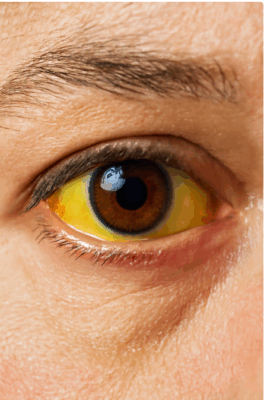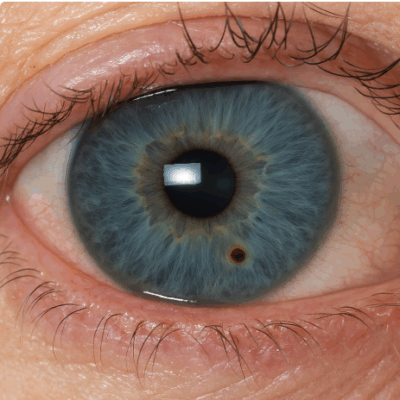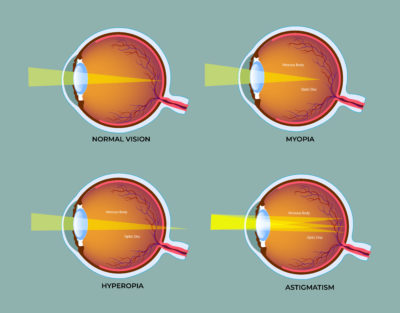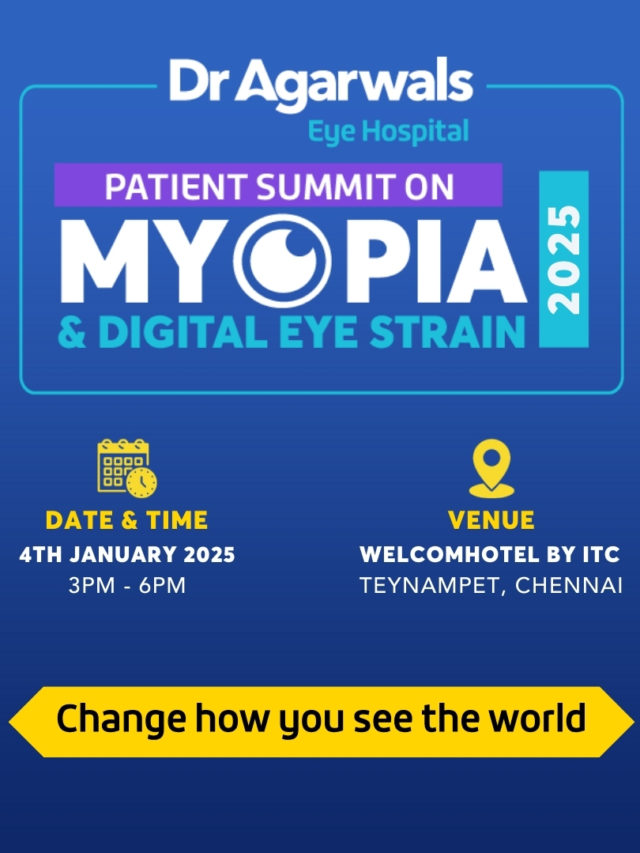Scleral icterus refers to the yellowing of the white part of the eyes (sclera) and is often one of the first visible signs of underlying health conditions. While mild yellow eyes may be linked to benign causes, persistent or worsening discolouration is usually associated with liver disease, blood disorders, or bile duct obstruction.
Understanding the meaning of icterus, its causes, symptoms, and treatment options is crucial for receiving timely medical care and preventing complications.
What Is Scleral Icterus?
Scleral icterus occurs when elevated bilirubin levels in the blood deposit in the sclera, giving it a yellowish tint. Bilirubin is a by-product of red blood cell breakdown that is processed by the liver. High bilirubin levels, or hyperbilirubinaemia, usually point to issues such as liver dysfunction, blood disorders, or bile duct obstruction.
Some people confuse the difference between the sclera and the conjunctiva. The sclera is the white part of the eye, while the conjunctiva is the thin tissue covering it. Yellowing is most visible in the sclera due to its high elastin content.

Causes of Scleral Icterus
Liver Disorders (Hepatitis, Cirrhosis, Liver Cancer)
Liver conditions are the most common causes. Hepatitis leads to liver inflammation, cirrhosis results from chronic scarring, and liver cancer disrupts normal function. All these reduce the liver’s ability to process bilirubin, leading to jaundiced eyes.
Blood-Related Conditions (Hemolysis, Sickle Cell Disease)
Excessive breakdown of red blood cells, known as haemolysis, releases large amounts of bilirubin into the bloodstream. Conditions like sickle cell disease, thalassemia, or autoimmune haemolytic anaemia often manifest with yellow eyes as an early symptom.
Obstructive Causes (Gallstones, Tumours, Cholangitis)
Blockages in the bile ducts prevent bilirubin from being excreted properly. Gallstones, tumours, or bile duct inflammation (cholangitis) are common obstructive triggers. This leads to a build-up of bilirubin in the body, presenting as icterus.
Genetic Liver Conditions (Gilbert’s Syndrome)
Some inherited liver disorders, such as Gilbert’s syndrome, impair the liver’s ability to process bilirubin efficiently. While usually harmless, they can still cause intermittent yellow eyes and mild fatigue.
Symptoms of Scleral Icterus
Yellowing of the Eyes (Sclera)
The hallmark sign of scleral icterus is the yellowing of the sclera, which may range from light to deep yellow depending on bilirubin levels.
Fatigue and Weakness
High bilirubin levels often accompany systemic effects, such as fatigue, weakness, and reduced stamina, reflecting the underlying causes of icterus.
Abdominal Pain
Discomfort in the upper right abdomen is a common symptom in cases of hepatitis, gallstones, or liver cancer. Pain often signals that more than just the eyes are affected.
Dark Urine and Pale Stools
Bilirubin excretion issues may cause urine to appear dark and stools to be pale, helping to differentiate jaundice eyes caused by liver or bile duct issues.
Nausea and Itchy Skin
Systemic symptoms such as persistent nausea, vomiting, and itching are linked to bilirubin build-up and bile acid imbalance in patients with scleral icterus.
Diagnosing Scleral Icterus
Blood Tests (Liver Function, CBC)
Liver function tests measure bilirubin, ALT, AST, and ALP to identify liver damage. A complete blood count (CBC) can detect anaemia or haemolysis as possible causes of icterus.
Imaging Tests (Ultrasound, CT Scan, MRI)
Ultrasound helps detect gallstones or bile duct obstruction, while CT and MRI provide detailed images of the liver, gallbladder, and bile ducts to evaluate the reason for yellow eyes.
Liver Biopsy
A biopsy may be required to confirm liver conditions such as cirrhosis or cancer, helping doctors understand the underlying cause of icterus.
Complete Eye Examination
An ophthalmologist may examine the eyes to differentiate between sclera and conjunctiva involvement and confirm the presence of scleral icterus.
Treatment Options for Scleral Icterus
Liver Disease Treatment (Antivirals, Nutritional Support, Transplant)
For hepatitis, antivirals may be prescribed, while cirrhosis often requires lifestyle changes and long-term care. In advanced cases, a liver transplant may be the only effective panophthalmitis treatment.
Gallstone and Bile Duct Obstruction Management
Gallstones can be treated with minimally invasive procedures such as endoscopic retrograde cholangiopancreatography (ERCP) to clear blockages. Tumours may require surgery or oncology-based management.
Blood Disorder Treatment (Medication, Blood Transfusions)
For haemolysis or sickle cell disease, medications and transfusions reduce red cell destruction and bilirubin production, thereby easing symptoms of scleral icterus.
Surgery for Bile Duct or Liver Obstructions
Surgical intervention may be necessary in cases of bile duct strictures or advanced liver tumours. This often helps relieve jaundiced eyes and other related signs.
Home Care and Preventive Measures
Hydration and Diet for Liver Health
Drinking plenty of water and eating a diet rich in leafy greens, fruits, and whole grains helps reduce strain on the liver and prevent worsening of scleral icterus.
Limiting Alcohol and Toxins
Alcohol is one of the major contributors to yellow eyes. Limiting alcohol and avoiding hepatotoxic drugs protects liver health and lowers the risk of chronic icterus.
Regular Medical Check-ups
Routine medical check-ups, including liver tests and eye exams, are important for people at risk of scleral icterus, especially those with a history of liver disease or genetic disorders.
When to See a Doctor for Scleral Icterus?
Seek immediate medical help if yellow eyes appear suddenly, worsen quickly, or are accompanied by severe abdominal pain, dark urine, or unexplained weight loss. As scleral icterus may indicate serious health problems like liver failure or cancer, early diagnosis and treatment are essential to prevent complications.
Conclusion
Scleral icterus is more than just a cosmetic issue. It reflects elevated bilirubin levels and often signals underlying health conditions. From liver disorders to blood-related issues or obstructive causes, the reasons are varied and often serious.
Timely diagnosis through blood tests, imaging, and eye examinations is vital. While treatments range from medication to surgery, lifestyle adjustments such as hydration, a healthy diet, and reduced alcohol use play an equally important role. If you notice persistent yellow eyes, consult a doctor promptly to address the root cause and protect long-term health.









